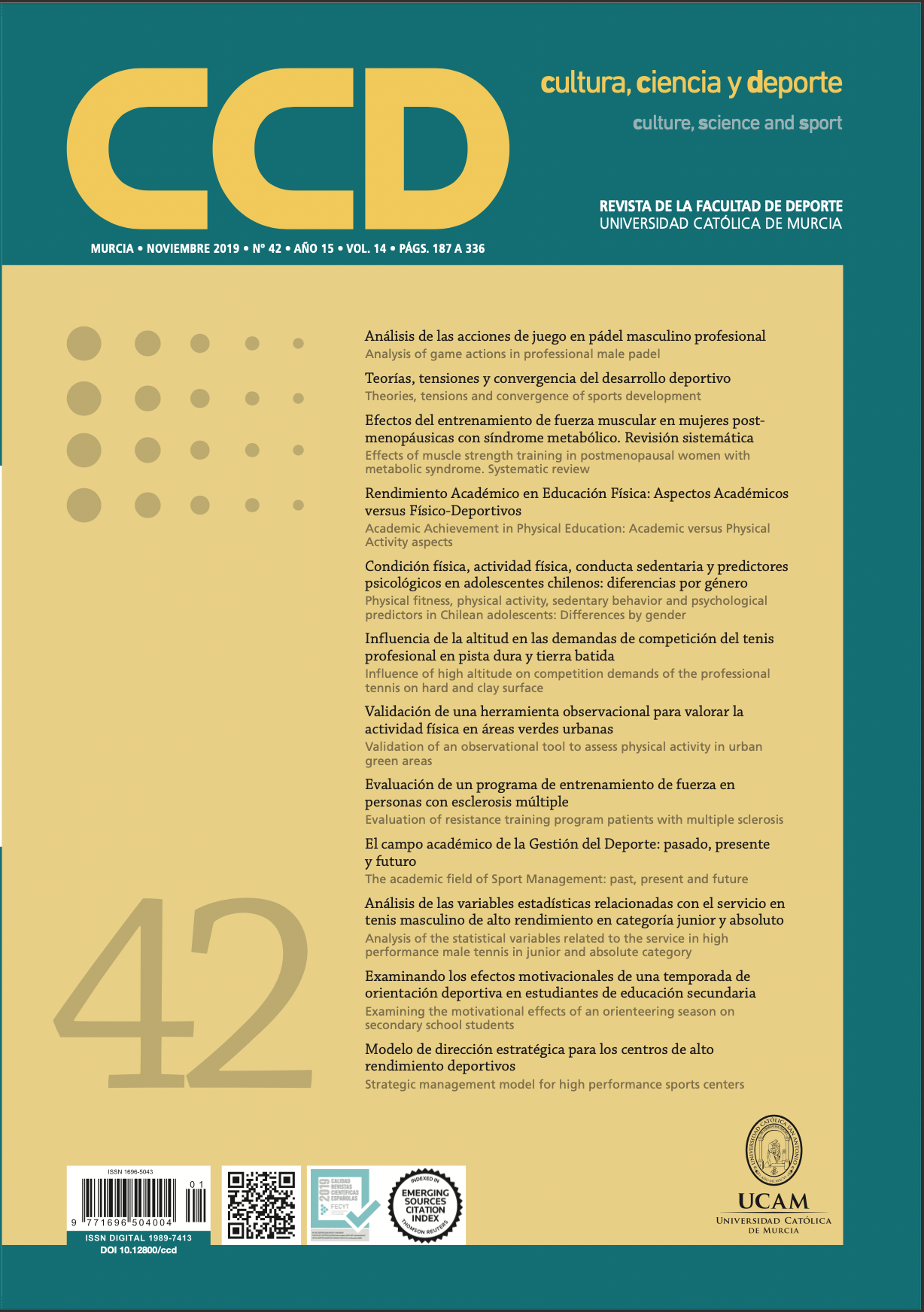Examinando los efectos motivacionales de una temporada de orientación deportiva en estudiantes de educación secundaria. (Examining the motivational effects of an orienteering season on secondary school students)
DOI:
https://doi.org/10.12800/ccd.v14i42.1343Palabras clave:
Educación Deportiva, orientación deportiva, motivación, educación físicaResumen
El principal propósito del estudio fue examinar el efecto de una temporada de orientación basada en el modelo de Educación Deportiva sobre la motivación del alumnado de educación secundaria. Se realizó un diseño pre-experimental con medidas pretest-postest, y se empleó una metodología cuantitativa y cualitativa para profundizar en la percepción discente y docente. Participaron 80 estudiantes (38 varones y 42 mujeres) de 3º curso de Educación Secundaria, con edades comprendidas entre los 14 y 17 años de edad (M = 14.62; DT = .80) y su profesor. La temporada comprendió 12 sesiones de 55 minutos. A nivel cuantitativo se emplearon las medidas de orientaciones de meta (TEOSQ), clima motivacional (PeerMCYSQ) y regulaciones motivacionales (PLOC-2). A nivel cualitativo se analizaron tres entrevistas al profesor, antes, tras la quinta sesión y al finalizar la unidad. No hubo diferencias significativas en ninguna de las regulaciones motivacionales. Se encontró un descenso significativo en la orientación a la meta tarea en la muestra total y los varones. Emergieron dos categorías: a) La orientación deportiva como contenido central y su influencia en la motivación del alumnado, y b) La orientación deportiva y su abordaje a través del modelo. La novedad, el dinamismo, la menor exigencia física, y el descenso de la carga teórica durante la unidad, junto con otros elementos del modelo (por ej., roles rotativos, implicación en la configuración de los grupos y fase competitiva) supusieron un efecto amortiguador de la caída motivacional.
=
The main purpose was to examine the effect of an orienteering Sport Education season on secondary school students´ motivation. A pre-experimental design was carried out with pretest-posttest measures, and a quantitative and qualitative methodology was used to know in deep the students and teacher perception. Participants were 80 students (38 men and 42 women) of the 3rd year of Secondary Education and their teacher. The age range was 14-17 years, with a mean age of 14.62 years (SD = .80). The orienteering season lasted 12 sessions of 55 minutes. At a quantitative level, the measures of goal orientations (TEOSQ), motivational climate (PeerMCYSQ) and motivational regulations (PLOC-2) were used. At a qualitative level, three interviews with the teacher were analyzed before, after the fifth session as well as at the end of the unit. There were no significant differences in any of the motivational regulations. There was a significant decrease in the task achievement goal orientation in the total sample and males. Two resulting categories emerged: a) orienteering as a central content and its influence on student motivation, and b) orienteering and its approach to the model. The novelty, the dynamism, the lower physical demand, joined to several elements of the model (p.ej., rotating roles, involvement in the configuration of the groups and competitive phase) were a dampening effect of the decline in motivation.
Citas
Abós, A., Sevil, J., Julián, J.A., Abarca-Sos, A., & García-González, L. (2016). Improving students’ predisposition towards physical education by optimizing their motivational processes in an acrosport unit. European Physical Education Review, 23(4), 444-460. doi:10.1177/1356336X16654390
Aguilar, S. & Barroso, J. (2015). La triangulación de datos como estrategia en investigación educativa [The triangulation of data as a strategy in educational research]. Píxel-Bit. Revista de Medios y Educación, 47, 73-88. doi:10.12795/pixelbit.2015.i47.05
Almolda-Tomás, F. J., Sevil-Serrano, J., Julián-Clemente, J. A., AbarcaSos, A., Aibar-Solana, A., & García-González, L. (2014). Application of teaching strategies for improving students’ situational motivation in physical education. Electronic Journal of Research in Educational Psychology, 12(2), 391-418.
Amado, D., Sánchez-Miguel, P. A., Leo, F. M., Sánchez-Oliva, D., & García-Calvo, T. (2013). Desarrollo de un modelo de motivación para explicar el flow disposicional y la ansiedad en bailarines profesionales. Universitas Psychologica, 12(2), 457-470. doi:10.11144/Javeriana. UPSY12-2.dmm
Ames, C. (1992). Achievement goals, motivational climate and motivational processes. En G. C. Roberts (Ed.), Motivation in sport and exercise (pp. 161-176). Champaign, IL: Human Kinetics.
Barkoukis, V., Taylor, I.M., Chanal, J., & Ntoumanis, N. (2014). The relation between student motivation and student grades in Physical Education: A three-year investigation. Scandinavian Journal of Medicine and Science in Sports, 5, 406-414. doi: 10.1111/sms.12174
Browne, T.B.J., Carlson, T.B., & Hastie, P.A. (2004). A comparison of rugby seasons presented in traditional and sport education formats. European Physical Education Review, 10(2), 199-214. doi:10.1177/1356336X04044071
Calderón, A., Hastie, P. A., & Martínez de Ojeda, D. (2010). Learning to teach Sport Education: initial experience in elementary education. Cultura_Ciencia_Deporte, 5(15), 169-180.
Calderón, A., Martínez-de-Ojeda, D., & Hastie, P. A. (2013). Students and teachers’ perception after practice with two pedagogical models in Physical Education. International Journal of Sport Science, 32(9), 137–153. doi:10.5232/ricyde2013.03204
Cecchini, J. A, Fernández, J. L., González, C., Fernández-Río, J., & Méndez-Giménez, A. (2012). La caída de la motivación autodeterminada en jóvenes escolares [The self-determined motivaton fall in school kids]. Sport TK. Revista Euroamericana de Ciencias del Deporte, 1(1), 25-31.
Chu, T. L., & Zhang, T. (2018). Motivational processes in Sport Education programs among high school students: A systematic review. European Physical Education Review, 1–23 doi: 10.1177/1356336X17751231
Cohen, L., & Manion, L. (2002). Métodos de investigación educativa [Educational research methods]. Madrid: La Muralla.
Cuevas, R., García-López, L.M., & Serra-Olivares, J. (2016). Sport Education Model and self-determination theory: An intervention in secondary school children. Kinesiology, 48(1), 30-38.
Curtner-Smith, M. D., Hastie P. A., y Kinchin, G. D. (2008). Influence of occupational socialization on beginning teachers’ interpretation and delivery of sport education. Sport, Education and Society 13(1) 97-117. doi:10.1080/13573320701780779
Deci, E.L., & Ryan R.M. (1985). Intrinsic motivation and self-determination in human behavior. New York, NY: Plenum Press.
Evangelio, C., González-Víllora, S., Serra-Olivares, J., & Pastor-Vicedo, J. C. (2016). El Modelo de Educación Deportiva en España: una revisión del estado de la cuestión y prospectiva [The Sport Education Model in Spain: a review of state of the art and Outlook]. Cuadernos de Psicología del Deporte, 16(1), 307-324.
Ferriz, R., González-Cutre, D., & Sicilia, A. (2015). Revisión de la Escala del Locus Percibido de Causalidad (PLOC) para la inclusión de la medida de la regulación integrada en Educación Física [Revision of the Perceived Locus of Causality Scale (PLOC) to include the measure of integrated regulation in Physical education]. Revista de Psicología del Deporte, 24(2), 329-338.
Flores, J., Salguero, A., & Márquez, S. (2008). Goal orientations and perceptions of the motivational climate in physical education classes among Colombian students. Teaching and Teacher Education, 24, 1441–1449. doi:10.1016/j.tate.2007.11.006
Gil-Arias, A., Harvey, S., Cárceles A., Práxedes, A., & del Villar, F. (2017). Impact of a hybrid TGfU-Sport Education unit on student motivation in physical education. PLoS ONE 12(6), e0179876. doi:10.1371/journal.pone.0179876
González-Cutre, D., Sicilia, A., & Moreno-Murcia, J. A. (2011). Un estudio cuasi-experimental de los efectos del clima motivador tarea en las clases de Educación Física [A quasi-experimental study of the effects of task-involving motivational climate in Physical Education classes]. Revista de Educación, 356, 677-700. doi:10-4438/1988-592XRE-2010-356-056
González-Cutre, D., Sicilia, A., Sierra, A. C., Ferriz, R., & Hagger, M. S. (2016). Understanding the need for novelty from the perspective of self-determination theory. Personality and Individual Differences, 102, 159-169. doi:10.1016/j.paid.2016.06.036
Granero, A., & Baena, A. (2007). Importancia de los valores educativos de las actividades físicas en la naturaleza. Habilidad Motriz, 29, 5-14
Hastie P. A., & Casey, A. (2014). Fidelity in models-based practice research in sport pedagogy: A guide for future investigations. Journal of Teaching in Physical Education, 33(3), 422-431.
Hastie, P. A., Sinelnikov, O. A., Wallhead, T., & Layne T. (2014). Perceived and actual motivational climate of a mastery-involving sport education season. European Physical Education Review, 20(2) 215-228. doi:10.1177/1356336X14524858
Hastie, P.A., & Trost, S.G. (2002). Student physical activity levels during a season of sport education. Pediatric Exercise Science, 14, 64-74. doi:10.1123/pes.14.1.64
Hastie, P.A., Sinelnikov, O.A., & Guarino, A.J. (2009). The development of skill and tactical competencies during a season of badminton. European Journal of Sport Science, 9(3), 133-140. doi:10.1080/17461390802542564
Hastie, P. A., Martínez, D., & Calderón, A. (2011). A review of research on Sport education: 2004 to present. Physical Education and Sport Pedagogy, 16(2), 103–132. doi:10.1080/17408989.2010.535202
Hortigüela-Alcalá, D., Pérez-Pueyo, A, & Calderón, A. (2016). Efecto del modelo de enseñanza sobre el autoconcepto físico del alumnado en educación física [Effect of the pedagogical model on the physical selfconcept of students in physical education]. Retos, 30, 76-81.
Kirk, D. (2013). Educational value and model-based practice in Physical Education. Educational Philosophy and Theory, 45(9), 973-986.
Lincoln, Y. S., & Guba, E. G. (1985). Naturalistic inquiry. Beverly Hills, CA: Sage Publications.
Martín, S., & Domínguez, M. (2006). El deporte de orientación en la naturaleza. Aportaciones a la Educación y el desarrollo de los alumnos, y sus relaciones con el currículo de Educación Física. Wanceullen: Educación Física Digital, 2. Recuperado de: www.wanceulen.com/revista/ numero2.mayo06
Méndez-Giménez, A., Fernández-Río, J., & Méndez-Alonso (2015). Modelo de Educación Deportiva versus Modelo Tradicional: Efectos en la motivación y deportividad [Sport Education model versus Traditional Model: effects on motivation and sportsmanship]. Revista Internacional de Medicina y Ciencias de la Actividad Física y el Deporte, 15(59), 449-466. doi:10.15366/rimcafd2015.59.004
Méndez-Giménez, A., Martínez de Ojeda, D., & Valverde, J.J. (2017). Emotional intelligence and motivational mediators in a season of Sport Education mime. Ágora para la Educación Física y el Deporte, 19(1), 52-72. doi:10.24197/aefd.1.2017.52-72
Méndez-Giménez, A., Puente-Maxera, F., & Martínez de Ojeda, D. (2017). Effects of a unit of mime based on the Sport Education model on interculturality. Sport TK. Revista Euroamericana de Ciencias del Deporte, 6(2), 89-100.
Menéndez-Santurio, J. I., & Fernández-Río, J. (2016). Efectos de un programa de kickboxing educativo sobre el papel importante del alumnado. Percepciones de estudiantes y profesorado. [Effects of an educational kickboxing program on students´ important role. Teachers and students´ perceptions]. SportTK. Revista Euroamericana de Ciencias del Deporte, 6(1), 91-100.
Meroño, L., Calderón, A., & Hastie, P. A. (2016). Effect of Sport Education on the technical learning and motivational climate of junior high performance swimmers. RICYDE. Revista internacional de ciencias del deporte. 44(12), 182-198. doi.org/10.5232/ricyde2016.04407
Metzler, M. W. (2011). Instructional models for physical education (2ª ed.). Scottsdale. AZ: Holcomb Hathaway Publishing.
Moreno-Murcia, J. A., López, M., Martínez, C. M., Alonso, N., & González-Cutre, D. (2006). Validación preliminar de la escala de percepción del clima motivacional de los iguales (CMI) y la escala de las orientaciones de meta en el ejercicio (GOES) con practicantes españoles de actividades físico-deportivas [Preliminary validation of the Peer Motivational Climate (PMC) Perception Scale and the Orientations Goals in the Exercise (OGE) Scale with Spanish participants of physical-sports activities]. Revista Iberoamericana de Psicología del Ejercicio y el Deporte, 1(2), 13-28.
Nicholls, J. G. (1984) Achievement motivation: Conceptions of ability, subjective experience, task choice, and performance. Psychological Review, 91(3), 328-346. doi:10.1037/0033-295X.91.3.328
Nunnally, J. C. (1978). Psychometric theory. New York: McGraw-Hill.
Ormond, T. C., DeMarco, G. M., Smith, R. M., & Fischer, K. A. (1995). Comparison of the sport education and traditional approaches to teaching secondary school basketball, Research Quarterly for Exercise and Sport (Supplement), A–66.
Pereira, J., Hastie, P., Araújo, R., Farias, C., Rolim, R., & Mesquita, I. (2015). A comparative study of students` track and field technical performance in Sport Education and in Direct Instruction approach. Journal of Sport Science and Medicine, 14, 118-127.
Perlman, D.J. (2010). Change in affect and needs satisfaction for amotivated students within the sport education model. Journal of Teaching in Physical Education. 29(4), 433-445. doi:10.1123/jtpe.29.4.433
Perlman, D.J. (2012). The influence of the Sport Education Model on developing autonomous instruction. Physical Education and Sport Pedagogy, 17(5), 493-505. doi:10.1080/17408989.2011.594430
Perlman, D.J., & Caputi, P. (2017). Examining the influence of Sport Education on the precursors of amotivation. European Physical Education Review, 23(2), 212-222. doi:10.1177/1356336X16643921
Perlman, D.J., & Goc Karp, G. (2010). A self-determined perspective of the sport education model. Physical Education and Sport Pedagogy, 15(4), 401-408. doi:10.1080/17408980903535800
Pritchard, T., Hawkins, A., Wiegand, R., & Metzler, J. N. (2008). Effects of two instructional approaches on skill development, knowledge, and game performance. Measurement in Physical Education & Exercise Science, 12(4), 219-236. doi:10.1080/10913670802349774
Puente-Maxera, F., Méndez-Giménez, A., & Martínez de Ojeda, D. (2018). Modelo de Educación Deportiva y rotación de roles. Efectos de una intervención sobre las variables motivacionales de estudiantes de primaria. Cultura_Ciencia_Deporte, 13(39), 281-290.
Siedentop, D. (1994). Sport Education: quality Physical Education through positive sport experiences. Champaign: Human Kinetics.
Siedentop, D., Hastie, P. A., & Van der Mars, H. (2011). Complete guide to Sport Education. Champaign, IL: Human Kinetics.
Sinelnikov, O. A. (2009). Sport education for teachers: Professional development when introducing a novel curriculum model. European Physical Education Review, 15, 91-114. doi:10.1177/1356336X09105213
Sinelnikov, O. A., & Hastie, P. A. (2010). A motivational analysis of a season of sport education. Physical Education & Sport Pedagogy, 15(1), 55-69. doi:10.1080/17408980902729362.
Sinelnikov, O. A., Hastie, P. A., & Prusak, K. A. (2007). Situational motivation during seasons of Sport Education. ICHPER-SD Research Journal, 2(1), 43–47.
Spittle, M., & Byrne, K. (2009). The influence of Sport Education on student motivation in physical education. Physical Education & Sport Pedagogy, 14(3), 253-266. doi:10.1080/17408980801995239
Wallhead, T. L. & Ntoumanis, N. (2004). Effects of a sport education intervention on students’ motivational responses in physical education. Journal of Teaching in Physical Education, 23, 4-18. doi:10.1123/ jtpe.23.1.4
Wallhead, T. L., Garn, A. C., Vidoni, C., & Youngberg, C. (2013). Game play participation of amotivated students during sport education. Journal of Teaching in Physical Education, 32, 149-165. doi:10.1123/ jtpe.32.2.149
Wang, J.C.K., Morin, A.J.S., Ryan, R.M., & Liu, W.C. (2016). Students’ motivational profiles in the physical education context. Journal of Sport and Exercise Psychology, 38(6), 1-46. doi:10.1123/jsep.2016-0153
Descargas
Publicado
Cómo citar
Número
Sección
Licencia
Los autores que publican en esta revista están de acuerdo con los siguientes términos:- Los autores conservan los derechos de autor y garantizan a la revista el derecho de ser la primera publicación del trabajo al igual que licenciado bajo una Creative Commons Attribution License que permite a otros compartir el trabajo con un reconocimiento de la autoría del trabajo y la publicación inicial en esta revista.
















